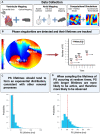The inspection paradox: An important consideration in the evaluation of rotor lifetimes in cardiac fibrillation
- PMID: 36148313
- PMCID: PMC9486478
- DOI: 10.3389/fphys.2022.920788
The inspection paradox: An important consideration in the evaluation of rotor lifetimes in cardiac fibrillation
Abstract
Background and Objective: Renewal theory is a statistical approach to model the formation and destruction of phase singularities (PS), which occur at the pivots of spiral waves. A common issue arising during observation of renewal processes is an inspection paradox, due to oversampling of longer events. The objective of this study was to characterise the effect of a potential inspection paradox on the perception of PS lifetimes in cardiac fibrillation. Methods: A multisystem, multi-modality study was performed, examining computational simulations (Aliev-Panfilov (APV) model, Courtmanche-Nattel model), experimentally acquired optical mapping Atrial and Ventricular Fibrillation (AF/VF) data, and clinically acquired human AF and VF. Distributions of all PS lifetimes across full epochs of AF, VF, or computational simulations, were compared with distributions formed from lifetimes of PS existing at 10,000 simulated commencement timepoints. Results: In all systems, an inspection paradox led towards oversampling of PS with longer lifetimes. In APV computational simulations there was a mean PS lifetime shift of +84.9% (95% CI, ± 0.3%) (p < 0.001 for observed vs overall), in Courtmanche-Nattel simulations of AF +692.9% (95% CI, ±57.7%) (p < 0.001), in optically mapped rat AF +374.6% (95% CI, 88.5%) (p = 0.052), in human AF mapped with basket catheters +129.2% (95% CI, ±4.1%) (p < 0.05), human AF-HD grid catheters 150.8% (95% CI, 9.0%) (p < 0.001), in optically mapped rat VF +171.3% (95% CI, ±15.6%) (p < 0.001), in human epicardial VF 153.5% (95% CI, ±15.7%) (p < 0.001). Conclusion: Visual inspection of phase movies has the potential to systematically oversample longer lasting PS, due to an inspection paradox. An inspection paradox is minimised by consideration of the overall distribution of PS lifetimes.
Keywords: atrial fibrilation; cardiac fibrillation; inspection paradox; phase singularity; renewal theory; ventricular fibrillation.
Copyright © 2022 Jenkins, Dharmaprani, Schopp, Quah, Tiver, Mitchell, Xiong, Aguilar, Pope, Akar, Roney, Niederer, Nattel, Nash, Clayton and Ganesan.
Conflict of interest statement
The authors declare that the research was conducted in the absence of any commercial or financial relationships that could be construed as a potential conflict of interest.
Figures





References
-
- Aliev R. R., Panfilov A. V. (1996). A simple two-variable model of cardiac excitation. Chaos, Solit. Fractals 7 (3), 293–301. 10.1016/0960-0779(95)00089-5 - DOI
-
- Angus J. E. (1997). Classroom note:the inspection paradox inequality. SIAM Rev. Soc. Ind. Appl. Math. 39 (1), 95–97. 10.1137/S003614459529298X - DOI
Grants and funding
LinkOut - more resources
Full Text Sources

